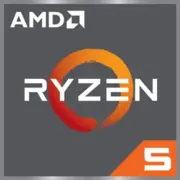AMD Ryzen 5 PRO 5675U

AMD Ryzen 5 PRO 5675U: A Balance Between Performance and Battery Life for 2025 Mobile Devices
March 2025
Introduction
AMD's Ryzen 5000 PRO series laptop processors remain relevant even in 2025, thanks to their successful combination of energy efficiency and computational power. In this article, we will analyze the Ryzen 5 PRO 5675U — one of the most popular mobile chips for business laptops and ultrabooks. We will look at its architecture, performance, battery life, and practical use cases.
1. Architecture and Process Technology: Zen 3 and 7nm Lithography
Cezanne-U: The Legacy of Zen 3
The Ryzen 5 PRO 5675U is built on the Zen 3 architecture (codename Cezanne-U). This generation brought key improvements:
- 6 cores and 12 threads with a base frequency of 2.3 GHz and a turbo boost up to 4.3 GHz.
- 16MB L3 cache—twice as much as the previous Ryzen 5 4000U models. This speeds up the processing of multi-threaded tasks and reduces latency.
- Integrated Radeon Graphics with 7 cores and a frequency of up to 1.8 GHz.
7nm TSMC FinFET Process Technology ensures low power consumption and compact die size. This is critical for thin laptops, where minimizing heat is important.
iGPU Features
The integrated graphics is based on the Vega architecture but optimized for use with DDR4-3200 or LPDDR4X-4266 memory. It handles:
- Office applications and rendering 4K interfaces.
- Light gaming: for example, CS:GO on medium settings achieves 45-55 FPS at 1080p resolution.
- Video acceleration in the browser (AV1 decoding).
2. TDP of 15W: How Does It Affect the Laptop?
Thermal Design Power and Cooling
A TDP of 15W allows the processor to be installed in ultrabooks with a thickness of up to 15mm without large cooling systems. In idle mode, the chip consumes only 3-5W, and under peak load — up to 25W (with temporary turbo mode support).
Practical Implications:
- Laptops with the Ryzen 5 PRO 5675U rarely overheat even during prolonged use of Adobe Photoshop or Excel.
- Fans are nearly silent during everyday tasks (web browsing, documents).
3. Performance: From Excel to Light Gaming
Geekbench 6: 1678 (Single-Core) / 5237 (Multi-Core)
These results place the 5675U on par with the Intel Core i5-1240P (Geekbench 6: ~1600/5800) and above the Apple M1 (1400/4500).
Real-World Tasks:
- Office Work: Simultaneously working with 30+ tabs in Chrome, Excel spreadsheets with 10,000 rows, and a Zoom conference — without lag.
- Multimedia: Rendering a 10-minute video in 1080p (using DaVinci Resolve) takes about 12 minutes.
- Gaming: Fortnite on low settings — 50-60 FPS, Dota 2 — 60-70 FPS (1080p).
Turbo Mode: How Long Does It Maintain Frequencies?
Under full-core load, the frequency drops from 4.3 GHz to 3.6-3.8 GHz after 2-3 minutes (depending on the cooling system). In ultrabooks with passive cooling (e.g., Lenovo ThinkBook 14 G6), throttling begins earlier — after 60-90 seconds.
4. Use Cases: Who Is the Ryzen 5 PRO 5675U Suitable For?
- Students and Freelancers: A lightweight laptop for studying, working with documents, and occasional video editing.
- Office Workers: Multitasking without slowdowns, supporting 2-3 external monitors via USB-C.
- Travelers: Battery life of up to 10 hours (with a 60 Wh battery).
- Not Suitable For: 3D modeling, streaming AAA games, or 4K video editing.
5. Battery Life: How AMD Saves Battery Charge
Energy-Saving Technologies:
- Precision Boost 2: Dynamically adjusts frequencies to avoid excessive heating.
- Adaptive Power Management: Lowers core voltage during idle.
- Support for LPDDR4X-4266: Energy-efficient memory reduces overall system consumption.
Examples of Battery Life (laptop with 53 Wh battery):
- Web browsing (brightness at 150 nits) — 9-10 hours.
- Video (YouTube, 1080p) — 8 hours.
- Workload (Photoshop + browser) — 4.5 hours.
6. Comparison with Competitors: AMD vs Intel vs Apple
- Intel Core i5-1345U (15W): Better in single-threaded tasks (Geekbench 6 Single-Core ~1750) but weaker in multi-threaded (~4900). Higher laptop prices ($900-1100).
- Apple M2 (MacBook Air): Better battery life (up to 15 hours) and graphics but limited compatibility with Windows software.
- AMD Ryzen 5 6600U (Zen 3+): Slightly higher performance (by 8-10%) but lacks PRO features like memory encryption.
Conclusion: The 5675U excels over competitors in the business laptop segment under $1000 due to its balance of price, security (Pro Security support), and performance.
7. Pros and Cons
Strengths:
- Ideal for multitasking.
- Support for USB4 and Wi-Fi 6E.
- Long battery life.
Weaknesses:
- Graphics are weaker compared to Ryzen 6000/7000 with RDNA 2.
- In gaming with turbo mode, the battery depletes in 2-3 hours.
8. Laptop Selection Recommendations
Types of Devices:
- Business Ultrabooks: HP EliteBook 845 G9, Lenovo ThinkPad T14s. Price: $850-1200.
- Versatile Laptops: ASUS ZenBook 14 OLED, Acer Swift 3. Price: $700-900.
What to Look For:
- Cooling: Better models with dual fans.
- Display: IPS or OLED with brightness of at least 300 nits.
- Memory: 16GB LPDDR4X (non-removable) — a minimum for 2025.
9. Final Conclusion
The Ryzen 5 PRO 5675U is an optimal choice for those seeking a reliable laptop for work and study without overspending. Its key advantages include:
- Ability to work 8-10 hours without a power outlet.
- Performance sufficient for 3-4 years.
- Support for modern standards (USB4, Wi-Fi 6E).
Target Audience: Users who don’t need maximum power but value comfort, mobility, and stability. In 2025, laptops with this processor can be found in the price range of $700-1100.
Basic
CPU Specifications
Memory Specifications
GPU Specifications
Miscellaneous
Benchmarks
Compared to Other CPU
Share in social media
Or Link To Us
<a href="https://cputronic.com/en/cpu/amd-ryzen-5-pro-5675u" target="_blank">AMD Ryzen 5 PRO 5675U</a>